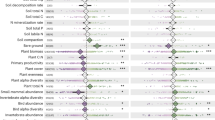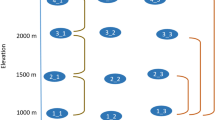Abstract
Tilman1 has developed a model to predict the number of plant species that can coexist competitively on a limited resource base. Species diversity first increases over low resource supplies, then declines as the environment becomes richer. Although Tilman's model was developed to describe interspecific interactions between plant species, it may also apply to animal species. Tilman1 questions whether animals specialize on particular proportions of nutrients. However, we believe animals probably specialize on relatively subtle microhabitat differences, especially in a multispecies competitive regime2. Thus, microhabitats may act like nutrients. We hypothesize that animal species, too, show a peaked curve of diversity over productivity. The present data provide a confirmation of the hypothesis using rodent species. We have investigated the number of rodent species along a geographical gradient of increasing rainfall. The gradient extends from extremely poor desert habitats to those with annual rainfall over 300 mm. Because of the aridity, precipitation reflects productivity. The diversity pattern in desert rodents agrees with that predicted by Tilman for plants. It even possesses similar asymmetry, rising steeply then falling slowly. The pattern is duplicated in rocky and sandy habitats, each of which has a distinct and almost non-overlapping assemblage of species. As mean precipitation is closely correlated with the variability of precipitation, the diversity pattern might also be caused by a decline in the frequency of disturbances, models for which have been proposed by several investigators.
This is a preview of subscription content, access via your institution
Access options
Subscribe to this journal
Receive 51 print issues and online access
$199.00 per year
only $3.90 per issue
Buy this article
- Purchase on Springer Link
- Instant access to full article PDF
Prices may be subject to local taxes which are calculated during checkout
Similar content being viewed by others
References
Tilman, D. Resource Competition and Community Structure (Princeton University Press, 1982).
Rosenzweig, M. L. Ecology 62, 327–335 (1981).
Walter, H. Jb. für wiss. Bot. 87, 750–860 (1939).
Haim, A. & Tchernov, E. Mammalia 38, 201–223 (1974).
Rosenzweig, M. L. Am. Nat. 102, 67–74 (1968).
Brown, J. H. Ecology 54, 775–787 (1973).
Brown, J. H. in Ecology and Evolution of Communities (eds Cody, M. L. & Diamond, J.) 315–341 (Belknap, Cambridge, 1975).
Abramsky, Z., Brand, S. & Rosenzweig, M. L. (submitted).
Rosenzweig, M. L. Science 171, 385–387 (1971).
Rosenzweig, M. L. in Ecology and Evolution of Communities (eds Cody, M. & Diamond, J.) 121–140 (Belknap, Cambridge, 1975).
MacArthur, R. H. Geogr. Ecol. (Harper & Row, New York, 1972).
McNaughton, S. J. Ecology 49, 962–972 (1968).
Abramsky, Z. Oecologia 34, 113–123 (1978).
Patrick, R. A. N. Y. Acad. Sci. 108, 359–365 (1963).
Kirchner, T. Ecology 58, 1334–1344 (1977).
Silvertown, J. J. appl. Ecol. 17, 491–5904 (1980).
Brown, J. H. & Gibson, A. C. Biogeography (Mosby, St. Louis, 1982).
Tappan, H. & Loeblich, A. R. Earth-Sci. Rev. 9, 207–240 (1973).
Oksanen, L., Fretwell, S. D., Arruda, J. & Niemela, P. Am. Nat. 118, 240–261 (1981).
Pimm, S. L. & Rosenzweig, M. L. Oikos 37, 1–6 (1981).
Bar, Y., Abramsky, Z. & Gutenmar, Y. J. Arid Envir. (in the press).
Grime, J. J. envir. Mgmt 1, 151–167 (1973).
Connell, J. H. Science 199, 1302–1310 (1978).
Huston, M. Am. Nat. 113, 81–101 (1979).
Levin, S. A. & Paine, R. T. Proc. natn. Acad. Sci. U.S.A. 71, 2744–2747 (1974).
Grubb, P. Biol. Rev. 52, 107–145 (1977).
Lubchenco, J. Am. Nat. 112, 23–39 (1978).
Conrad, V. Mon. Weath. Rev. 69, 5–11 (1941).
Author information
Authors and Affiliations
Rights and permissions
About this article
Cite this article
Abramsky, Z., Rosenzweig, M. Tilman's predicted productivity–diversity relationship shown by desert rodents. Nature 309, 150–151 (1984). https://doi.org/10.1038/309150a0
Received:
Accepted:
Issue Date:
DOI: https://doi.org/10.1038/309150a0
This article is cited by
-
Negative density dependence mediates biodiversity–productivity relationships across scales
Nature Ecology & Evolution (2017)
-
No correlation between the diversity and productivity of assemblages: evidence from the phytophage and predator assemblages in various cotton agroecosystems
Science China Life Sciences (2014)
-
Influence of dune stabilization on relationship between plant diversity and productivity in Horqin Sand Land, Northern China
Environmental Earth Sciences (2012)
-
A reverse keystone species affects the landscape distribution of woodland avifauna: a case study using the Noisy Miner (Manorina melanocephala) and other Australian birds
Landscape Ecology (2011)
-
Relationship between species richness and biomass on environmental gradient in natural forest communities on Mt. Xiaolongshan, northwest China
Forestry Studies in China (2008)
Comments
By submitting a comment you agree to abide by our Terms and Community Guidelines. If you find something abusive or that does not comply with our terms or guidelines please flag it as inappropriate.



